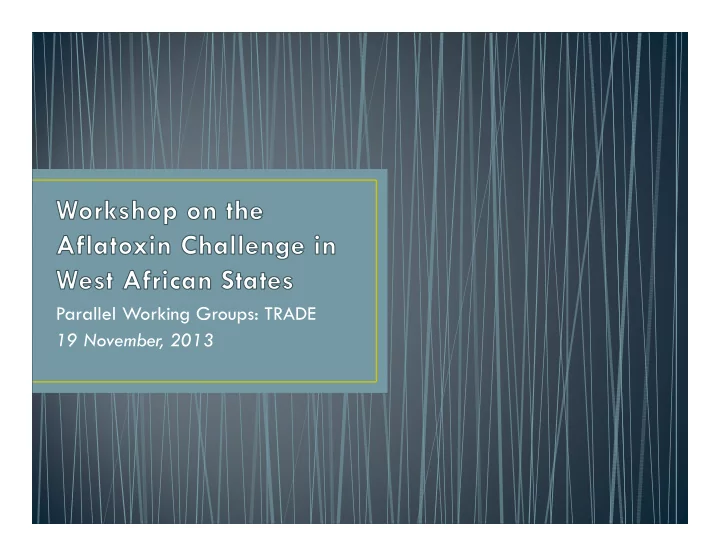

Parallel Working Groups: TRADE 19 November , 2013
• Moussa Coulibaly • Adebowole Akande • Rose Omari • Marietou Diawara • Mustapha B. Colley • Wezi Chunga-Sambo
• Difficulty in meeting export standards • Standards are too high • Export rejects • Down-grading of products hence low price is offered • Standards are not harmonized in West Africa • Difficulty in reducing aflatoxin level • Countries do not focus on groups that give them competitive advantage • Lack of focus on control of aflatoxin in domestic markets • Too much focus on the international market to the detriment of local, sub-regional and regional markets
• Lack of standards for specific food products e.g., maize, maize flour, groundnut paste • Absence of aflatoxin standard developed based on our consumption patterns • Lack of testing laboratories • Some W/A countries do not have standards embedded in their food safety legislation • Lack of focus on the informal markets (major food traders) • Awareness is limited to large-scale traders (not the entire food chain) • Lack of data on the actual economic losses due to aflatoxin contamination
• Existing business (market) opportunities • Governments’ awareness of aflatoxin problem • High demand for aflatoxin susceptible products in W/A and other international countries • A number of policies within ECOWAS into which we can integrate aflatoxin issues • Many initiatives and activities are already on-going in W/A that can be leveraged- there are learning opportunities
• Create awareness across the entire value chain • Establish functional and certified laboratories – countries should learn best practices • Create standards for both human food and animal feed • Set-up regulatory body for the informal markets • Capacity building on best practices • Infrastructure development e.g., dryers, storage facilities, testing kits, build modern markets with sheds and storage facilities • Socio-economic research on actual economic losses • Public and private sector investment in aflatoxin reduction technologies
Solution Prioritization 1. Awareness creation Short-term 2. Capacity building- Short-mid term 3. Establish standards mid-long term 4. Set up laboratories mid-long term 5. Set up regulatory bodies for the mid-term informal markets 6. Infrastructural development Short-mid-long term 7. Investment in technology mid-long term 8. Research mid-long term
• Top Four Solutions 1. Awareness creation and capacity building 2. Setting standards and regulations (including regulatory bodies for the informal markets) 3. Infrastructural development 4. Innovation and investment in technology
Activity 1: Awareness creation and capacity building- What could be done? • Design a country strategy and harmonize it across the region • Organize country and regional workshops • Policy advocacy at country level • Create national Mycotoxin Associations and they should be formalized • Establish a W/African aflatoxin awareness Day
Activity 1: Awareness creation and capacity building- Who will take the lead? • Multi-stakeholders involvement • Public, • Private • Civil society Lead Ministry: Ministry of Trade Other stakeholders: Active participation
Activity 1: Awareness creation and capacity building- How could it be accomplished, next steps? • These could be accomplished through Human and Financial resource mobilization
Activity 2: Standards and regulations--What could be done? • Set up committees to come up with standards and regulations • Draft standards and regulations to be validated at country levels • Establish institutions to administer the standards and regulations • Awareness creation on the standards • Monitoring the effective implementation of the standards • Organize workshops and seminars to harmonize countries’ standards and regulations into the regional standards and regulations
Activity 2: Standards and regulations--Who will take the lead? • Technical departments (Technocrats), • Private sector, • Civil society and farmers Lead: National Governments and ECOWAS Other stakeholders: Implementation
Activity 2: Standards and Regulations- How could it be accomplished, next steps? • Through financial and human resource mobilization Next Steps: • Implementation • Monitoring and evaluation
Activity 3: Infrastructural development including laboratories--What could be done? • Set up a Committee of experts to take stock of existing national and regional infrastructure as well as available human resource: • Conduct a needs assessment, find the gaps and fill them • Financial and Human resource mobilization
Activity 3: Infrastructural development including laboratories--Who will take the lead? • Regional (ECOWAS) and National • Scientists • Private Sector Lead: Committee of experts comprising of regional and national scientists and private sector Other: Assist in the financial resource mobilization and support the process
Activity 3: Infrastructural development including laboratories-- How could it be accomplished, next steps? • Through financial and human resource mobilization (internal and external) Next Steps: • Implementation • Monitoring and evaluation
Relevant National Level Frameworks/Policies/Initiatives • Nigeria --NAVDAC • Senegal -- institute of food technology, using aflasafe, exports have a standard- phytposanitary certificate – DPV, quarantine, framework for importing grain needs to be enforced in informal trade. • Gambia --national standards, standards beaurau. CODEX committee has got standards for various crops. Food Law— control levels of aflatoxins in the local market Regional Level Frameworks/Policies/Initiatives -- ??
Recommend
More recommend